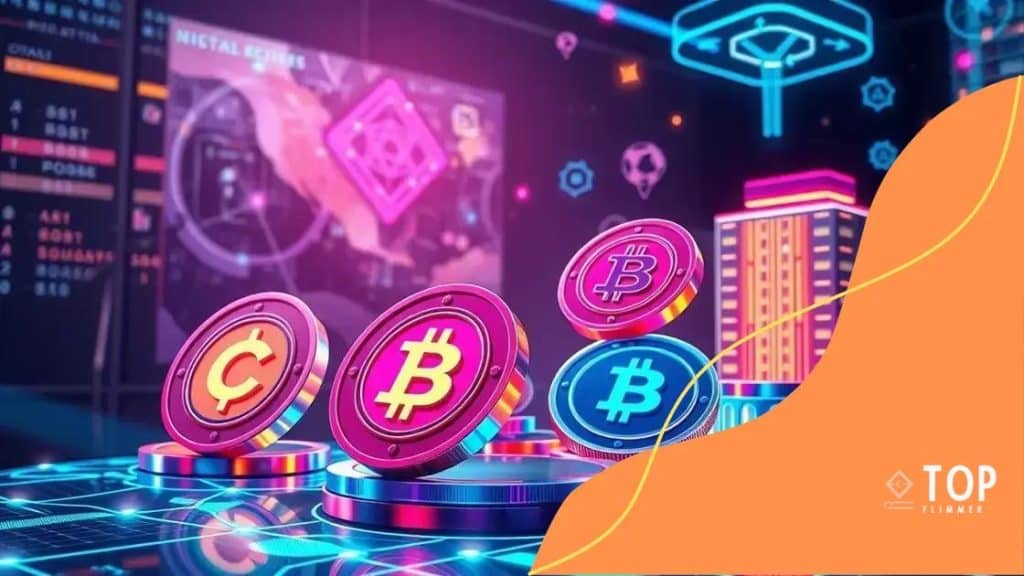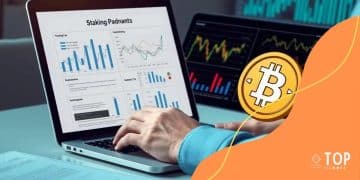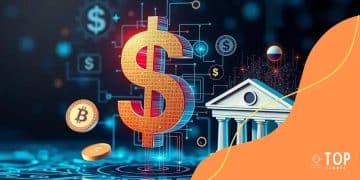Understanding NFTs: Beyond Digital Art

NFTs, or non-fungible tokens, are unique digital assets that represent ownership of content and can be bought, sold, or created on various online marketplaces using cryptocurrencies like Ethereum.
Understanding NFTs is essential as they reshape the digital landscape. But did you know their significance extends beyond just art? Let’s explore how they’re changing ownership and value in the digital world.
What are NFTs and how do they work?
Non-fungible tokens (NFTs) are a unique type of digital asset that represent ownership of a specific item or piece of content, often recorded on a blockchain. Unlike cryptocurrencies such as Bitcoin, which are fungible and can be exchanged one for another, NFTs are distinct. This uniqueness is what lends value and authenticity to these digital assets.
NFTs can represent various forms of digital creations, including artwork, music, videos, and even virtual real estate in online worlds. They function primarily through smart contracts on a blockchain, which provide transparent proof of ownership and transaction history.
How NFTs Work
The process of creating an NFT involves several steps. Initially, the creator, such as an artist, produces a digital file. Next, this file is minted and transformed into an NFT on a blockchain. Minting involves uploading the digital file to a platform that supports NFT creation, like Ethereum-based operations. Once the minting is completed, the NFT is stored on the blockchain, where its details are permanently recorded.
- Blockchain Technology: NFTs use blockchain tech, ensuring transparency and security.
- Smart Contracts: These automate and facilitate transactions between buyers and sellers.
- Ownership Records: Each NFT has an unchangeable record of its ownership history.
When someone buys an NFT, they receive a digital certificate of ownership verified by the blockchain. This doesn’t mean they own the copyright to the content, but they have exclusive rights to sell, trade, or showcase the token.
The Significance of NFTs
The rise of NFTs has revolutionized various sectors, transforming how digital content is valued and monetized. Artists, musicians, and creators reap the benefits of direct sales, eliminating intermediaries. Moreover, NFTs have created a new avenue for collectors and investors seeking unique digital assets. Each NFT holds potential value that can appreciate over time, depending on market demand and the asset’s desirability.
This shift towards tokenization means that many traditional sectors are exploring using NFTs, from gaming to real estate. As this technology continues to develop, understanding how NFTs work becomes increasingly important for participants in the digital economy.
Real-world applications of NFTs
Real-world applications of NFTs showcase their versatility beyond digital art. They are making waves in various industries, changing how we view ownership and authenticity.
From music to gaming and even real estate, NFTs are transforming traditional practices. For artists, NFTs provide a new way to monetize their work directly, bypassing galleries and auction houses. Musicians can sell exclusive album releases as NFTs, granting fans ownership of their unique tracks.
NFTs in Gaming
In the gaming industry, NFTs are allowing players to own their in-game assets. This is a shift from conventional gaming, where players purchase items but do not truly own them. With NFTs, items such as skins, characters, and land can be bought, sold, and traded across platforms.
- Ownership: Players genuinely own their items, which can increase in value.
- Interoperability: Some NFTs can be used across different games.
- Player-driven economies: Gamers can earn real money by selling their NFTs.
Real estate is another area where NFTs are leaving a mark. Virtual land can be bought as NFTs in online platforms like Decentraland. Users can develop their property, host events, or even sell it for a profit. This innovative approach is redefining what it means to own property in a digital space.
Collectibles and Sports
Collectibles have always been popular, but NFTs elevate them to new levels. Sports teams are creating NFTs for memorable moments, allowing fans to own highlights from their favorite games. These digital collectibles can be a great investment, as their value may rise over time.
With the rise of NFTs, industries are finding new ways to engage audiences, pushing the boundaries of what can be considered valuable. As the technology evolves, more applications will likely emerge, making NFTs a significant part of the future economy.
Challenges and criticisms of NFTs

Despite their growing popularity, NFTs face several challenges and criticisms that must be addressed. These issues range from environmental concerns to concerns about copyright and ownership.
One major criticism involves the environmental impact of NFTs. Most NFTs are created and traded on platforms that use blockchain technology requiring significant energy consumption. As a result, the carbon footprint associated with these transactions has raised alarms among environmentalists and activists.
Copyright and Ownership Issues
The questions of copyright and ownership are also prominent in the discussion about NFTs. When someone buys an NFT, they often receive only a digital token representing the asset, not the copyright to the underlying content. This can create confusion about what buyers actually own and what rights they have regarding the digital asset.
- Misunderstanding Ownership: Many buyers may think they own the copyrighted material when they do not.
- Plagiarism Concerns: Artists’ works can be minted without their consent, leading to unauthorized sales.
- Legal Ambiguities: The current legal framework may not adequately protect creators and buyers.
Another challenge is market volatility. The value of NFTs can fluctuate wildly, driven by speculation and trends in the digital art world. This can create a risky environment for investors who may lose money if the market shifts drastically.
Security Risks
Security is also a significant concern. NFTs can be vulnerable to hacks and scams, putting buyers’ investments at risk. Cases of stolen NFTs or fraudulent listings have emerged, highlighting the importance of security in the NFT space.
As the industry grows, addressing these challenges and criticisms will be crucial for its sustainability. Solutions may involve enhancing transparency, implementing better legal protections, and finding ways to reduce environmental impact.
The future of NFT technology
The future of NFT technology looks promising as it expands into various sectors beyond digital art. Innovations are continually emerging, which could reshape how we think about ownership and transactions in the digital realm.
NFTs have the potential to revolutionize identity verification. In the future, they could serve as unique digital identities for individuals, simplifying online interactions while enhancing security. This could be particularly useful in sectors like finance, healthcare, and education.
Integration with Virtual Reality and the Metaverse
As virtual reality (VR) and the metaverse gain popularity, NFTs are poised to play a crucial role. Users might buy, sell, and trade virtual assets in immersive environments, further blurring the lines between digital and physical realities. This creates exciting opportunities for gaming, social interactions, and commerce within virtual spaces.
- Creating virtual real estates: Users can own and develop land in virtual worlds.
- Unique experiences: Brands could offer limited-edition virtual events or products as NFTs.
- Investment opportunities: The intersection of NFTs and virtual assets could lead to new investment avenues.
Another area of growth is in functional NFTs, which could hold utility beyond mere ownership. For example, NFTs might grant access to events, memberships, or exclusive content. This utility adds another layer of value to digital assets.
Sustainability Efforts
The future of NFTs will likely also focus on addressing sustainability concerns. New technologies are being developed to reduce the energy consumption associated with NFT transactions. Solutions like proof-of-stake blockchains and eco-friendly minting processes could help the NFT market become more environmentally friendly.
With advancements in technology and evolving market demands, the future of NFTs is not just about digital art; it is about creating a more interconnected and efficient digital economy. As new applications are discovered, NFTs will likely become integral to our digital lives.
How to get involved with NFTs
Getting involved with NFTs can seem daunting, but it is quite accessible once you understand the basics. There are several steps you can take to start your journey in this exciting space.
The first step is to choose a digital wallet. A wallet will help you store your cryptocurrencies and NFTs securely. Popular options include MetaMask and Trust Wallet. Setting up a wallet is straightforward, and many platforms provide easy instructions to guide you through the process.
Buying Cryptocurrency
Once you have a wallet, you will need to buy some cryptocurrency. Depending on the NFT platform you choose, Ethereum (ETH) is often required. You can purchase Ethereum on exchanges like Coinbase or Binance. Simply create an account, link your bank account, and buy your desired amount of ETH.
- Research cryptocurrency exchanges: Find reputable exchanges that fit your needs.
- Be mindful of fees: Different exchanges have varying fees, so choose wisely.
- Secure your account: Use strong passwords and two-factor authentication for safety.
After acquiring crypto, the next step is exploring NFT marketplaces. Well-known platforms include OpenSea, Rarible, and Foundation. Each has unique features and offerings, so take your time to explore which one suits you best.
Buying or Creating Your First NFT
When you’re ready, you can buy your first NFT or even create one yourself. If buying, browse through the available collections and select an NFT you like. Make sure to verify the seller’s credibility and understand any additional fees involved in the purchase.
If you’re more creative, consider minting your own NFT. This process involves uploading your digital work to a marketplace and following their minting procedure. Ensure to include a clear description and any relevant details so potential buyers understand the value of your work.
As you become more involved in the world of NFTs, stay informed about trends and news. Joining communities on platforms like Discord and Twitter can help you connect with others who share your interests. Engaging with communities can provide valuable insights and opportunities to collaborate.
FAQ – Frequently Asked Questions about NFTs
What is an NFT?
An NFT, or non-fungible token, is a unique digital asset that represents ownership of a specific item or piece of content, often stored on a blockchain.
How can I buy my first NFT?
To buy your first NFT, set up a digital wallet, purchase cryptocurrency like Ethereum, and browse NFT marketplaces like OpenSea to find and buy NFTs.
Can I create my own NFT?
Yes, you can create your own NFT by minting your digital assets on an NFT marketplace. This process typically involves uploading your work and following the platform’s minting steps.
What should I consider before investing in NFTs?
Before investing in NFTs, consider the potential market volatility, research the asset’s value, check the credibility of sellers, and understand copyright issues.






